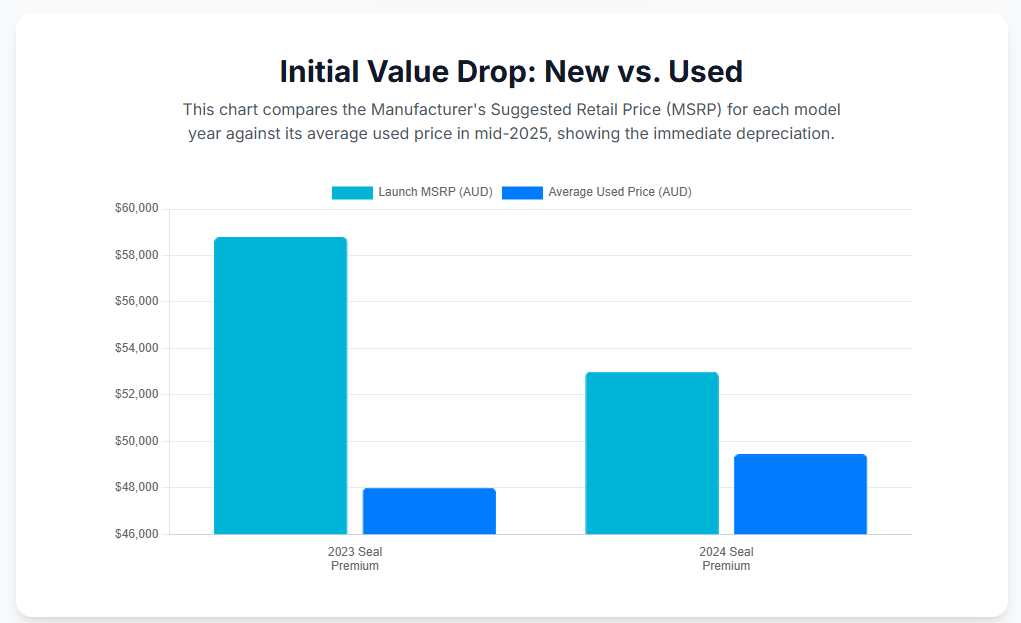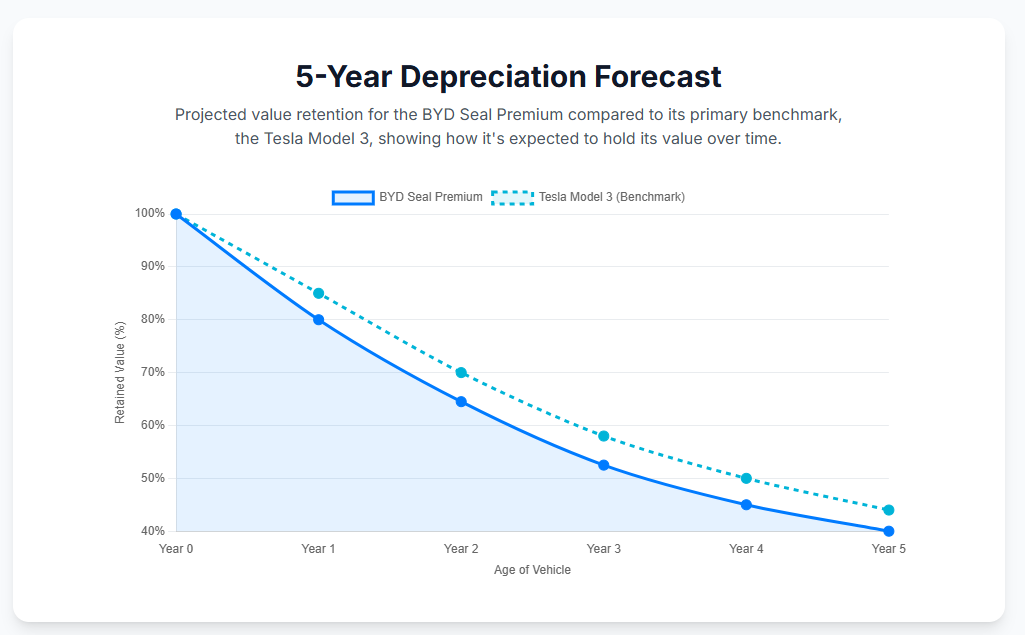Australia’s electric vehicle market is buzzing, and no brand has made a more dramatic entrance than BYD. With its sleek design and aggressive pricing, the BYD Seal sedan has emerged as a serious challenger to the throne long held by the Tesla Model 3. But for savvy buyers, the sticker price is only half the story. The real question is: how well does it hold its value?
This article provides a detailed look into the depreciation of the BYD Seal in Australia, analysing its performance since its launch, forecasting its future value, and exploring the key factors every potential owner should understand.
The Seal’s Place in the Market
Launched in Australia in October 2023, the BYD Seal arrived with a clear mission: to offer a premium EV experience without the premium price tag.
The Seal is available in three trims: Dynamic, Premium, and Performance. For this analysis, we are focusing on the Premium model. With a substantial 570 km of WLTP range, a powerful 230 kW motor, and luxury features like genuine leather seats and a Head-Up Display, it’s widely considered the “sweet spot” of the range. It offers the best balance of features and range for its price, making it the most popular choice for Australian families and a strong indicator of the model’s overall market performance.
Table 1: BYD Seal Australian Trim Specifications and Launch Price
| Trim Level | Drivetrain | Battery (usable) | Range (WLTP) | Power | Launch MSRP (AUD, excl. on-roads) |
| Dynamic | RWD | 61.4 kWh | 460 km | 150 kW | $49,888 |
| Premium | RWD | 82.6 kWh | 570 km | 230 kW | $58,798 |
| Performance | AWD | 82.6 kWh | 520 km | 390 kW | $68,798 |
The Numbers So Far What is a Used BYD Seal Worth?
The BYD Seal is still very new, but by analysing the used car market in mid-2025, we can see how the first models are faring.
A 2023 BYD Seal Premium, which had a launch MSRP of around $58,798, is now listed on the used market for between $46,000 and $49,990. This represents a first-year depreciation of roughly 15% to 22%.
For the 2024 models, which saw a slightly lower MSRP in some cases, the percentage drop is less severe. However, the data clearly shows that the market value of a nearly-new Seal is heavily influenced by the price of a brand-new one.
This initial drop might seem steep, but it’s crucial to understand the context. The EV market is currently in the midst of an intense price war, which dramatically affects the value of all-electric cars, not just the Seal.

This chart shows the initial depreciation hit for the first two model years of the BYD Seal Premium, comparing its launch price to average used prices in mid-2025.
What’s Driving the Numbers? The Three Key Factors
The value of a used BYD Seal isn’t just about its age or kilometres. Three major forces are shaping its depreciation curve.
1. The Great EV Price War
This is the single biggest factor. In 2023 and 2024, Tesla enacted a series of dramatic price cuts on the new Model 3 and Model Y to stimulate demand. Because the Model 3 is the Seal’s main competitor, these price drops had an immediate and powerful ripple effect. When the price of a new Tesla falls by thousands of dollars, the value of every used EV on the market, including the BYD Seal, is instantly recalibrated downwards. Early adopters of the 2023 Seal felt this most acutely, as the value of their asset was impacted by competitor actions that occurred after their purchase.
2. Brand Newness and Trust
BYD might be a global giant, but it’s a new name for many Australians. While its sales have been meteoric—becoming a top-five selling brand in Australia in under three years—it doesn’t yet have the decades-long reputation of brands like Toyota. This can make some used car buyers hesitant, which tends to push resale values down. However, BYD’s rapid growth suggests it is quickly earning consumer trust.
3. Technology and the Fear of Obsolescence
Electric cars are evolving at lightning speed. The Seal is packed with modern tech, including BYD’s impressive “Blade Battery.” However, its DC charging speed, while adequate at 150 kW, is already being surpassed by rivals that can charge much faster. Furthermore, while the Seal’s hardware and build quality receive high praise, some reviewers have noted that its driver-assistance software can be overly sensitive or “annoying.” In a car defined by its technology, the perception of dated or frustrating software can accelerate depreciation and deter second-hand buyers.
Looking Ahead A 3-Year Depreciation Forecast
So, what can a BYD Seal owner expect over the next few years? To forecast this, we can use the Tesla Model 3 as a benchmark. The Model 3 has been in Australia since 2019, giving us a rich history of how a direct competitor performs in this volatile market.
By combining the Seal’s known first-year depreciation with the historical trends of the Model 3, we can project its future value. This forecast assumes the EV price war will continue and that BYD’s brand presence will keep growing.
Table 2: Projected Depreciation Schedule – BYD Seal Premium
| Age (Years) | Projected Retained Value (%) | Projected Resale Value (from $58,798 MSRP) |
| End of Year 1 | 78% – 82% | $45,860 – $48,215 |
| End of Year 2 | 62% – 67% | $36,455 – $39,395 |
| End of Year 3 | 50% – 55% | $29,400 – $32,340 |
This means that after three years, a BYD Seal Premium is projected to be worth roughly half of its original purchase price.

This chart compares the projected depreciation curve of the BYD Seal Premium against its main rival, the Tesla Model 3, over five years.
The Verdict Is the BYD Seal a Smart Buy?
The BYD Seal is, without a doubt, a fantastic new car. It offers an incredible amount of style, technology, and performance for the money. For a new car buyer focused on getting the most bang for their buck, it’s one of the most compelling options on the market.
However, its long-term value is exposed to significant market risks. The aggressive pricing strategies of its competitors, especially Tesla, mean its resale value could be more unpredictable than that of a traditional petrol car.
The projected three-year retained value of 50-55% might seem low, but it’s essential to look at the whole picture. Because the Seal has a lower starting price than many of its rivals, the total amount of money you lose in depreciation—the actual dollars out of your pocket—could be less than a more expensive car that holds its value better as a percentage.
Ultimately, the BYD Seal represents a trade-off. It offers outstanding value upfront in exchange for higher potential risk in its long-term resale value. For a buyer who understands the dynamic and fast-changing nature of the EV market, it stands as a financially savvy and highly enjoyable choice.
BYD is booming in my city. I had a test drive few weeks ago and the dealer said it is compatible with my EVDANCE charger. Maybe I will get one in the future. https://evdances.com/